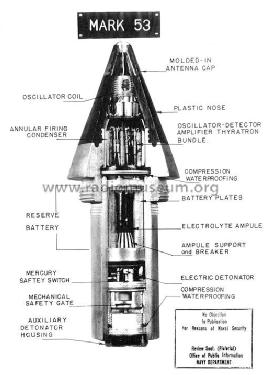Proximity Fuse MK53-Fuze
Crosley Radio Corp.; Cincinnati (OH)
- País
- Estados Unidos
- Fabricante / Marca
- Crosley Radio Corp.; Cincinnati (OH)
- Año
- 1942–1945

- Categoría
- Equipo Militar (sin Re, Tr y TRX)
- Radiomuseum.org ID
- 294836
- Numero de valvulas
- 0
- de Radiomuseum.org
- Modelo: Proximity Fuse MK53-Fuze - Crosley Radio Corp.;
- Anotaciones
-
Picture from Naval History and Heritage Command. We don't know for certain if the tube CK501X and/or 932 was used for this model and/or what others, but can presume it.
The first types of proximity fuses was designed with radio tubes, not transistors or ICs since this was much earlier! Later, proximity fuses like the M734 fuze were designed and built with much more knowledge and available technique. See also 1Ж36Б = 1j36b tube from the USSR and this article with nice photos about the tube SN-856-F, probably for the MK56 proximity fuze. British tubes are for instance the E1180, E1228, E1330 (CV123) and the CV2, CV3 for proximity fuses.The proximity fuse was invented by the British but rought to the US for further improvement and design plus mass production and had the biggest impact in the war against Japan 1942 through 1945.
"Three critical secret projects were pivotal for the Allied victory in WW2. Two of these were the development of the atomic bomb and radar. The third was the development of the proximity or VT (Variable Time) fuze. ... Prior to the war two types of fuzes were used: the timed fuze was set to explode at a predetermined time after firing and the contact fuze, used in smaller caliber weapons, exploded on contact with an object. Neither was effective against the highly maneuverable airplanes that had been developed since the end of the First World War. The British began the development of a projectile which would automatically detonate in close proximity to the target in 1939 and the American effort began in early 1940. ... Although primarily a supplier to the Navy for use in the Pacific and the Mediterranean theaters, Crosley fuzes were used with great success by the British against the V-1 buzz bomb, by the U.S. Army on the European continent in the defense of Antwerp against V-1 attacks and in the Battle of the Bulge. ... Bureau of Ordnance figures show that Crosley produced 5,205,913, or 24%, of the slightly more than twenty-two million proximity fuzes manufactured during the war." With this text you will find the original article with an exploded view of the Mark 53 Fuze.
- Ext. procedencia de los datos
- Wikipedia under proximity fuse
- Autor
- Modelo creado por Ernst Erb. Ver en "Modificar Ficha" los participantes posteriores.
- Otros modelos
-
Donde encontrará 1813 modelos, 1053 con imágenes y 1306 con esquemas.
Ir al listado general de Crosley Radio Corp.; Cincinnati (OH)
